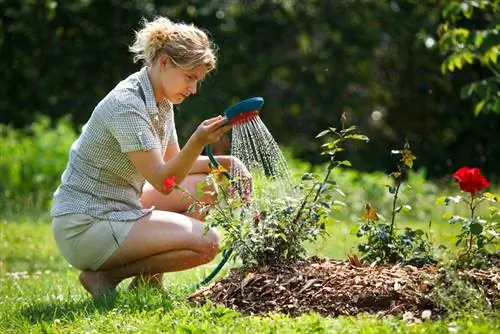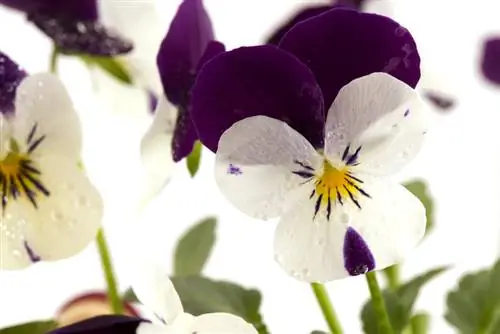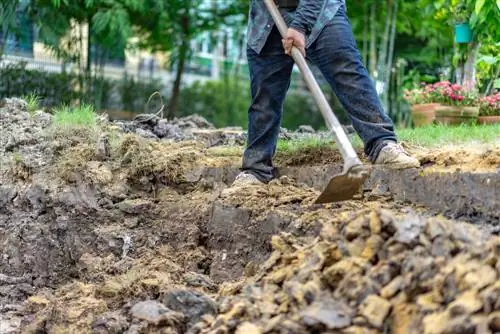- Author admin [email protected].
- Public 2023-12-16 16:46.
- Last modified 2025-01-23 11:20.
Roses are popular but quite demanding garden plants. A beautifully blooming rose bush is a wonderful eye-catcher, but you should take good care of it - only then will you be able to enjoy the beautiful flowering plant for a long time. By the way, how you care for it properly depends primarily on the type and variety of rose. You can find detailed instructions for optimal rose care in the following article.

How do you optimally care for roses?
The optimal rose care includes regular watering in dry conditions, fertilizing with complete organic fertilizer in March and June, mulching, professional pruning between the end of March and the beginning of April, as well as winterizing by piling up and covering with breathable materials.
What is the best way to water roses?
Roses should only be watered if they are dry for a long time. However, if possible, this should be done in such a way that the leaves do not get wet. Rose petals that are moist for a long time are often affected by star sooty mold, but also by rose rust. From September you should no longer water roses so that the shoots become woody and frost hardy.
How should you fertilize roses?
Roses are heavy-feeding plants, which is why fertilization and thus a regular supply of nutrients is essential. The first fertilization takes place in March, when you spread about one to two fingers of compost or other humus substances between the roses and work them flat into the soil. At the same time, provide the plant with a complete organic fertilizer, for example a good rose fertilizer (€11.00 on Amazon). However, fertilizers that contain a lot of nitrogen, such as blue grain, are not particularly suitable for roses because they stimulate growth but suppress flowering. Spring fertilization is finally repeated in June, unless you have used a slow-release fertilizer from the start.
Does mulching roses make sense?
Mulching, in which a layer of grass clippings about ten centimeters thick is spread between the roses, has proven particularly useful in dry regions. This eliminates the need to loosen the soil, and the soil under the mulch remains moist and saves you from having to water too often. However, if you mulch with bark mulch, you should also add nitrogen in organic or mineral form. This is intended to cover the needs of soil organisms that would otherwise pull it out of the ground. As a result, the roses suffer from nitrogen deprivation.
When and how should you cut roses?
Most roses are cut back when the forsythia is in bloom, i.e. around the end of March to the beginning of April. Completely remove all thin and frozen shoots, while reducing the remaining ones to around three to four eyes - this corresponds to a length of around 20 centimeters. For vigorously growing varieties, a few more buds can be left. In general, at least half of the shoot length is cut away, but be careful: how severe the pruning is and whether it can be cut at all (some rose varieties are only thinned out!) varies depending on the variety.
The stronger the pruning, the stronger the new growth
The same rule of thumb applies to roses as to fruit trees: the more pruning occurs, the stronger the new growth. The few remaining buds then produce only a few, but particularly long and strong shoots. On the other hand, weak pruning, which leaves many eyes behind, results in only weak shoots: numerous but short shoots are produced. Consequently, noble roses that are intended to develop particularly long shoots should be cut back vigorously; Bed roses, on the other hand, are weaker so that the bushes don't get too tall.
Cutting floribunda roses
For floribunda roses, it is usually sufficient if all weak and spindly shoots are removed and the remaining ones are only shortened by about a quarter to a third of their length. If the lower parts become bare over the years and their flowering slows down, they will be strongly rejuvenated, i.e. H. cut back into the old wood.
Cutting shrub and wild roses
Shrub roses and bush-like wild roses are only thinned out, i.e. H. They remove dry and very thin shoots as well as those that are too close together. The natural shape of the shrub should be retained, as the bushes will then become even more beautiful. Only for shrub rose varieties with very long, annual shoots are they shortened by half. The spent parts of wild roses do not need to be removed as these species develop rose hips. However, with shrub roses that bloom several times and with climbing roses, this work should not be overlooked, otherwise fruit will set and the second bloom will be very weak.
Cutting climbing roses
Climbing roses are also thinned out if possible. Only newly planted climbing roses are shortened by at least half. Older shoots, recognizable by their dark wood, are removed directly from the ground or, if strong young shoots have developed near the ground, they are returned to them. Overaged climbing roses can be cut back radically.
How can you winterize roses?
At the start of heavier frosts, i.e. from around mid-November, climbing and bed roses are piled up to a height of around 20 centimeters. To do this, use a hoe to pull the soil from the rose bed onto the individual bushes or place a third to half a bucket of compost soil on each plant. This is then covered with spruce branches. Standard roses and delicate roses are well packaged for the winter, preferably with jute or other breathable materials. Foil, on the other hand, is not very suitable.
Tip
Roses can also be overwintered by laying down the crown in late autumn. To do this, carefully bend them to the ground and cover them with about 20 centimeters of soil.






